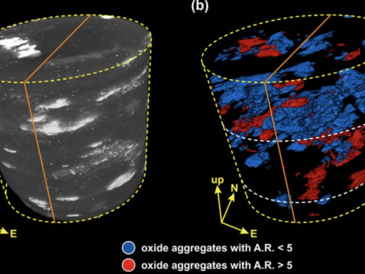Nicole Dilissen, Károly Hidas, Carlos J.Garrido, Wolf-Achim Kahl,Vicente López Sánchez-Vizcaíno, José Alberto Padrón-Navarta
Lithos (2018) 320-321, 470-489
https://doi.org/10.1016/j.lithos.2018.09.033
The Almirez ultramafic massif (SE Spain) preserves the transformation of high-P antigorite (Atg-) serpentinite to chlorite (Chl-) harzburgite (1.6–1.9 GPa; 680–710 °C), a metamorphic reaction that is the primary source of water at the intermediate depth of subducting slabs. We present a detailed μ-CT and EBSD study of oriented samples across the Atg-serpentinite dehydration isograd to investigate the textural evolution during serpentinite dehydration to peridotite and its relation to stress orientations and the kinematics of subducting slabs.
Above the Atg-out isograd, Atg-serpentinite shows a prograde mylonitic foliation and a weak Shape Preferred Orientation (SPO) of oxide aggregates defining a N—S stretching lineation. The antigorite Crystal Preferred Orientation (CPO) is characterized by [001]Atg perpendicular to the foliation, and the poles to (100)Atg and (010)Atg distributed in a girdle-like symmetry with [100]Atg nearly parallel to the stretching lineation. The antigorite microstructure and CPO are consistent with deformation by dislocation creep, twinning, and dissolution-precipitation creep. These textures record the long-term shear deformation near the slab interface where the main compressive stress, σ1, was at an acute angle to the foliation.
Below the Atg-out isograd, Atg-serpentinite dehydrated to unfoliated, coarse-grainedChl-harzburgite with granofels or spinifex textures distributed in alternating decameter-sized lenses. Crystallization of granofels and spinifex Chl-harzburgite records, respectively, a sequence of slow and fast fluid draining events during serpentinite dehydration under the same orientation of the principal stresses that resulted in the shear deformation of the Atg-serpentinite. Both textural types exhibit coarse-grained textures with systematic mineral CPOs and SPOs and microstructures without evidence of major ductile deformation. The texture of the granofels Chl-harzburgite formed by a topotactic dehydration reaction after Atg-serpentinite coupled to compaction leading to an olivine layering subparallel to the Atg-serpentinite foliation. The olivines of granofels Chl-harzburgite are rounded and display a weak CPO that can be accounted for by the topotactic reaction 〈100〉Atg||〈100〉Ol and (001)Atg||(010)Ol after Atg-serpentinite. Similarly, orthopyroxene shows a marked CPO consistent with the topotactic reaction (100)Opx||(001)Atg and [001]Opx||[100]Atg.
Spinifex Chl-harzburgite displays systematic mineral SPO and CPO. Spinifex olivines are tabular on (100)Ol and elongated along [001]Ol (c > b >> a), and define a ESE–WNW platelet lineation. The average texture is characterized by [001]Ol,Opx subparallel to a strong ESE–WNW oxide aggregate lineation, and [100]Ol,Opx and [001]Ol,Opx within a plane of similar orientation to the Atg-serpentinite foliation. The SPOs and CPOs of spinifex Chl-harzburgites are composed of up to four orientation populations of tabular olivines, where one population is volumetrically dominant in all samples. Relative to the main orientation population, the CPO of olivine shows clustered distribution of [100]Ol and [010]Ol maxima rotated at systematic angles around [001]Ol. These clustered CPOs and SPOs show a remarkable correlation with the orientation of the principal paleostresses. The preponderant orientation population of tabular olivines lies on the plane of maximum compression (σ2–σ3 plane) and has [010]Ol and its (100)Ol tabular faces nearly perpendicular to the Atg-serpentinite foliation. This population can be accounted for by oriented growth of platy crystals perpendicular to σ1. The other populations lie in the plane perpendicular to the least compressive stress (σ3) and the planes of maximum shear. The driving force and causes for the oriented crystallization of tabular olivine in these planes is uncertain, but their correlation with paleostresses suggests a cause-effect relationship.
Spinifex and granofels Chl-harzburgites show a marked ESE–WNW oxide aggregate lineation that differs in orientation from that of Atg-serpentinite and is approximately parallel to the intermediate compressive stress (σ2). These lineations and the platelet lineation of spinifex Chl-harzburgite may be due to along-strike fluid flow below the permeability barrier that constituted the Atg-out dehydration isograd. Our study shows that the kinematics of the slab, paleostresses, and fluid flow exert a dynamic control on the textures of Atg-serpentinite dehydrating to peridotite in subducting slabs.


